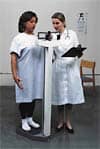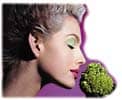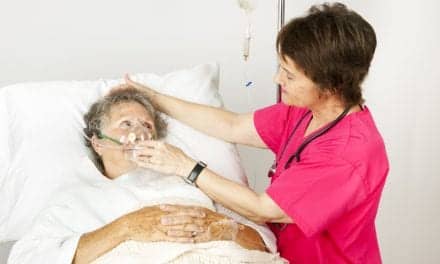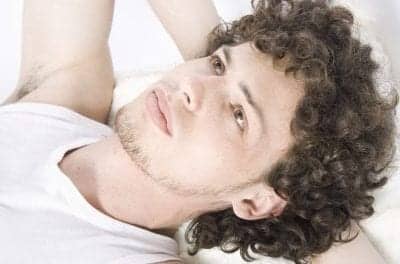An overweight female patient with sleep-related eating and nocturnal eating syndrome benefited from weight loss and CPAP titration.

Behaviors
Parasomnias can manifest themselves as a variety of behaviors. For example, nightmares (during REM sleep), night terrors (during non-REM sleep), hypnic jerks, sleep talking, and sleepwalking are classified as disorders of arousal.2 Night terrors are often displayed when the patient is in a state of great agitation or fear. In the case of somnambulism, patients often show an uncoordinated gait early in the event. Both gait and coordination improve with the duration of the event, to the point of supporting the performance of detailed, skilled tasks.3 Somnambulistic patients often show little facial emotion during the event. They have a flat affect, unless they are otherwise agitated. While the eyes are open, they appear dull and unfocused. Within a relatively short time, the patient goes back to bed, awakening the next morning with little or no memory of the previous night’s activities.
It is widely contended that these episodes most frequently occur during slow-wave sleep.3 In addition, the episodes are precipitated by an arousal mechanism,4 either internal or external. In the laboratory setting, technologists have reported witnessing and recording night-terror episodes immediately following the closing of a door nearby. In this situation, the sound of the door closing serves as an audible stimulus sufficient to provoke a parasomnia episode.
Multiple Pathologies
Arousal cues do not have to be external, and it is common to see multiple pathologies. For example, obstructive sleep apnea (OSA) is commonly diagnosed in conjunction with secondary periodic limb-movement disorder. Patients with both of these disorders frequently display an abnormally high incidence of nocturnal arousals precipitated by the individual episodes of OSA and periodic limb movement. If an OSA patient has a respiratory disturbance index (RDI) of 50, it is characteristic to see a matching (or nearly matching) arousal index. The patient nears or reaches the depths of slow-wave sleep and then experiences frequent arousals due to the primary pathology, but these arousals trigger the parasomnia event.
Therefore, it stands to reason that if the parasomnia patient is relieved of the internal arousal mechanism, the behavioral episodes should decrease. In 1993, this approach was taken by Schenck et al.5 By alleviating OSA, they dispersed the parasomnias of two patients.
Parasomnias are not always triggered by a mechanical stimulus. According to Schenck and Mahowald,6 sleepwalking can be aggravated by various medical, psychiatric, and neurological disorders. Likewise, both stress and sleep deprivation can lower the threshold for episode occurrence. This is also a common characteristic of epilepsy. Due to the similarities in behavior of a postictal patient and a parasomnia patient, many sleep practitioners order expanded electroencephalographic (EEG) montage polysomnographic recordings to rule out epilepsy. Situations involving irregular sleep-wake schedules can also trigger parasomnia episodes. These disruptions can include shift changes and poor sleep hygiene. Benca and Casper7 have also reported that abstinence from alcohol and nicotine can exacerbate sleep-related eating episodes. Drug therapy using monoamine oxidase inhibitors, lithium carbonate, and amitriptyline can also trigger parasomnia activity.5
Case Study
In early 1996, a female patient came to the Sleep Disorders Center of Alabama, Birmingham, for a consultation with Robert Doekel, MD, medical director. The patient, a licensed practical nurse, had visited her family physician concerning her sleep-wake problems. She was subsequently referred to Doekel for further consultation and potential evaluation.
In the prior year, the patient had noticed an increase in daytime sleepiness, and she was having difficulty concentrating. She noticed difficulty especially in driving home from work. She was beginning to experience an increase in rise-time headaches and blood pressure. The patient’s husband, an emergency-department registered nurse, also reported witnessing apneic events during her sleep and had noted an increase in the frequency of her snoring. In addition, the patient had experienced a weight gain of 23 to 27 kg over the previous 5 years. Despite the fact that the patient had undergone a tonsillectomy, physical examination revealed excessive tissue in the areas of the uvula and soft palate. The patient’s questionnaire also revealed a 30 pack-year smoking history. Furthermore, she was a diurnal sleeper employed as a night nurse by a local prison.
These characteristics would be considered fairly typical of a presenting apnea patient, but this patient had a distinctive complaint: she was a sleepwalker. Not only did she have a long history of somnambulism, but she also prepared food and ate it during her sleep. This is referred to as sleep-related eating.
Sleep-related eating is considered a parasomnia specifically associated with sleepwalking.5 Patients with nocturnal eating syndrome are aroused during their sleep and cannot go back to sleep unless they get up and eat. This means that they are fully alert and awake, with cognitive function. This case was not a situation in which the patient merely got up during the night and prepared something to eat; she had sleep-related eating disorder.7 The patient was not only asleep during the event, but showed little discrimination in what she ate.

After having been interviewed and evaluated by Doekel, the patient was scheduled for a diurnal polysomnogram. The first study revealed that her sleep efficiency was high, at 92.1%. Her sleep was 3.4% stage 1, 82.8% stage 2, 7.4% slow-wave, and 6.4% REM. Because the percentages of REM and slow-wave sleep were low, the proportion of stage-2 sleep was elevated. The patient’s oxygen saturation averaged 95.4%, and she experienced only one low saturation level (89%). Her apnea-hypopnea index for the overall study was 8.1 episodes per hour, and she experienced a total of 54 events. Most of the respiratory events occurred while the patient was in non-REM sleep (specifically, stage 2). For the 8.1 episodes per hour, however, the associated apnea arousal index was 7.9. The patient experienced a periodic limb-movement index of 16.1 episodes per hour (108 total movements). The associated periodic limb-movement arousal index for the study was 15.5. All told, the patient experienced a total arousal index of 23.4 episodes per hour; this is clinically significant. When completing the center’s postsleep questionnaire, the patient reported that she had dreamed that she was moving. She also reported having a headache and a dry throat.
Due to the outcome of the first study, Doekel ordered a study for the following day that would include continuous positive airway pressure (CPAP) titration. During CPAP use, the patient’s overall sleep was greatly improved. A review of her sleep architecture revealed an improvement in REM sleep (to 28.2%) and a decrease in stage-2 sleep (to 56.8%). Her sleep efficiency remained at 91.6%. Her oxygen saturation level averaged 94.5% and never went below 94% during the study. Titration showed CPAP to be most effective for this patient at a pressure of 15 cm H2O, which produced an RDI of less than five episodes per hour. During the entire titration study, the patient experienced a total of 45 respiratory-related arousals (index=6.4); however, consideration must be given to the fact that the study included CPAP titration. There are residual respiratory events (with arousals) associated with this process. Unfortunately, the periodic limb-movement index remained at a level of 122 events during the titration study (index=17.4). There were only 63 events that triggered arousals (index=9), but when viewed for the entire night, the overall arousal index was 14.1 episodes per hour. Given the previous night’s arousal index (23.4), the patient experienced an improvement (decreased arousals) of 40%.. Furthermore, she reported on her postsleep questionnaire that she awakened very rested and recalled awakening only two times during the night. There was no mention of headaches or other bodily discomforts.
Based on the results of both sleep studies, Doekel prescribed home CPAP therapy. In addition, he recommended that the patient reduce her weight from 131 kg to 104 kg. While this weight still appears to be excessive, the goal was to bring her weight down in a realistic manner. The patient was also instructed to remain in contact with the CPAP therapists at the center. The center’s own statistics have shown that constant contact between patient and therapists has produced increased patient compliance during therapy.
Since the time of the patient’s initial studies, many remarkable events have occurred. Most noteworthy has been a total reduction in parasomnia events. In follow-up care, the patient reported that she has neither recollection nor evidence of eating in her sleep. While this condition was secondary to her respiratory and arousal disorders, CPAP has greatly improved her nocturnal activities. The patient reported being quite skeptical of CPAP when she first went home with the unit. After having skipped two nights of CPAP use shortly thereafter, she was quick to report that she felt physically unwell as a result. This situation made her realize the benefits of continuous CPAP therapy. Unfortunately, she did not say whether she had experienced any parasomnia events during the time away from CPAP therapy
Another positive change the patient has experienced has been a weight reduction of 53 kg. At the time of her most recent office visit in 1999, her weight was 78 kg. One of the many goals of CPAP therapy is to reduce arousals during sleep. CPAP patients can experience a decrease in excessive daytime somnolence with an increase in energy and activity levels. Subsequently, patients returning to the office for follow-up visits present with remarkable weight loss.
If CPAP therapy had failed, another approach might have been mandibular advancement. The goal of the bite plate would be treatment of respiratory disturbances (thus controlling the underlying sleep disorder), but its secondary benefit would be its reduction of arousals. Schenck and Mahowald6 have also recommended dopaminergic agents (such as levodopa and clonazepam) for those patients with concomitant periodic limb-movement disorder. Behavioral treatments have been reported as largely ineffectual.6,7
Conclusion
To date, the patient has had no further complaints of sleep-related eating. She has remained consistent in adhering to her therapy recommendations. The reduction in nocturnal arousals accomplished through the treatment of her underlying sleep disorder has reduced her nocturnal activities.
Allen Boone, RPSGT, is assistant director, Sleep Sciences Inc, Institute of Sleep Medicine, Birmingham, Ala.
References
1. Reite M, Ruddy J, Nagel K. Evaluation and Management of Sleep Disorders. London: American Psychiatric Press; 1997.
2. Thorpy M. Handbook of Sleep Disorders. New York: Marcel Dekker; 1990.
3. Kelly D. Sleep and dreaming. In: Kandel E, Schwartz J, Jessel T, eds. Principles of Neural Science. New York: Elsevier Science Publishing; 1991:803-819.
4. Shouse M, Mahowald M. Epilepsy and sleep disorders. In: Kryger M, Roth T, Dement W, eds. Principles and Practice of Sleep Medicine. 3rd ed. Philadelphia: WB Saunders; 2000:707-723.
5. Schenck C, Hurwitz T, O’Connor K, Mahowald M. Additional categories of sleep-related eating disorders and the current status of treatment. Sleep. 1993;16:457-466.
6. Schenck C, Mahowald M. Parasomnias: managing bizarre sleep-related behavior disorders. Postgrad Med. 2000;107:145-156.
7. Benca R, Casper R. Eating disorders. In: Kryger M, Roth T, Dement W, eds. Principles and Practice of Sleep Medicine. 3rd ed. Philadelphia: WB Saunders; 2000:1169-1175.




